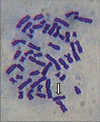Tobacco dust induced genotoxicity as an occupational hazard in workers of bidi making cottage industry of central India
- PMID: 24748730
- PMCID: PMC3989910
- DOI: 10.4103/0971-6580.128785
Tobacco dust induced genotoxicity as an occupational hazard in workers of bidi making cottage industry of central India
Abstract
Context: To explore genotoxicity in bidi rollers occupationally exposed to bidi tobacco dust.
Aims: To assess the extent of genotoxicity of tobacco dust to bidi rollers of Jabalpur, Madhya Pradesh, India and cytotoxicity of bidi tobacco extract.
Settings and design: Blood samples from 31 bidi rollers and 30 controls taken after written informed consent were analyzed for chromosome aberrations (CA) and comet assay.
Materials and methods: Genotoxicity was studied by CA in cultured peripheral blood lymphocytes of bidi rollers and the deoxyribonucleic acid (DNA) damage studies were done by comet assay of their blood. The toxicity of bidi tobacco extract to normal human lymphocytes was studied by MMT (3-[4,5-dimethylthiazol-2-yl]-2,5 diphenyl tetrazolium bromide) assay as drop in viability.
Statistical analysis used: Student's t-test and DMRT.
Results: There is a general trend of increase in CA% of both in exposed and control groups with age, but in every group the bidi rollers have a significantly higher CA% than the controls. The CA % is also directly related to exposure. The comet assay findings reveal that the mean comet length and tail length increases with exposure time. The toxicity of bidi tobacco extract (TE) to normal human lymphocytes was tested in vitro by 3-[4,5-dimethylthiazol-2-yl]-2,5 diphenyl tetrazolium bromide (MTT) assay at 2 h of incubation. The trend of drop in viability with increasing concentrations of TE was clearly evident from the data from four donors in spite of their individual differences in viability.
Conclusions: The results obtained in this investigation indicate that bidi rollers seem to be facing the occupational hazard of genotoxicity due to handling bidi tobacco and inhalation of tobacco dust. They should be advised to work under well-ventilated conditions.
Keywords: Chromosome aberration; MTT assay; comet assay; genotoxicity in bidi rollers; tobacco dust.
Conflict of interest statement
Figures






References
-
- Karabi MM, Bhavna MB. New Delhi, India: Organization: Voluntary Health Association of India; 2010. Tobacco and poverty research and capacity building: Narrative Report.
-
- Mahimkar MB, Bhisey RA. Occupational exposure to bidi tobacco increases chromosomal aberrations in tobacco processors. Mutat Res. 1995;334:139–44. - PubMed
-
- Umadevi B, Swama M, Padmavathi P, Jyothi A, Reddy PP. Cytogenetic effects in workers occupationally exposed to tobacco dust. Mutat Res. 2003;535:147–54. - PubMed
-
- Haber H, Raber W, Vetter N. Bronchial asthmatic disease associated with tobacco dust: An occupational lung disease. Wien Klin Wochenschr. 2004;116:38–9. - PubMed
LinkOut - more resources
Full Text Sources
Other Literature Sources

